Analysis of Labor Issues in the Canadian Tourism Industry
VerifiedAdded on 2022/11/18
|8
|2409
|1
Report
AI Summary
This report examines the labor shortages and challenges within the Canadian tourism industry. It highlights the importance of the tourism sector to Canada's economic growth and development, emphasizing its role in job creation and foreign exchange. The report identifies key issues such as the scarcity of skilled labor, particularly in the hospitality sector, and the impact of immigration policies on the labor market. It also addresses problems related to employee training, wages, and working conditions, which contribute to high employee turnover. Furthermore, the report explores strategies that human resource professionals can implement to improve the situation, including introducing fixed and variable income schemes, advocating for immigration policy modifications, providing training and certification programs, and offering competitive benefits packages. The conclusion underscores the need for proactive measures to enhance the tourism experience and ensure the industry's continued success.
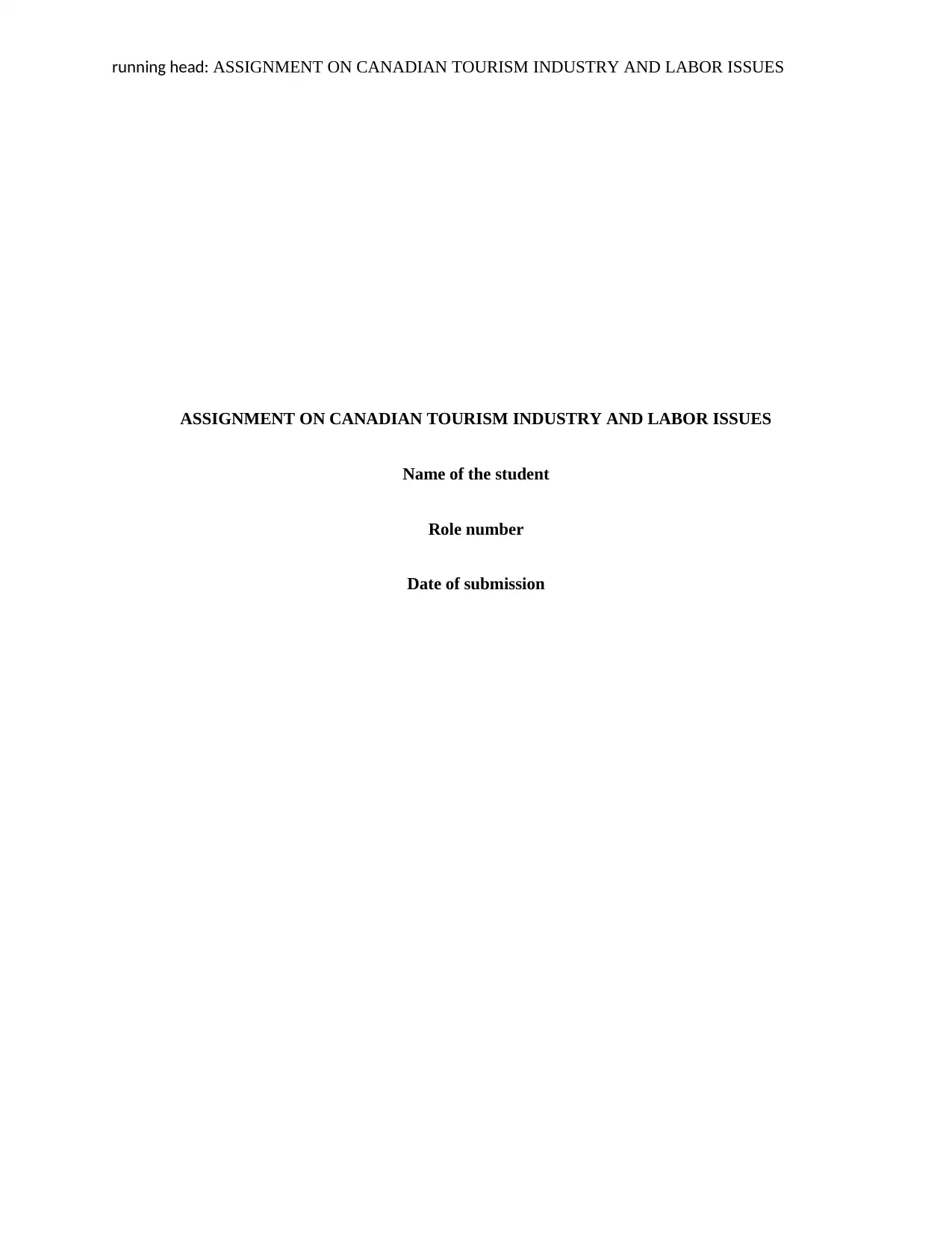
running head: ASSIGNMENT ON CANADIAN TOURISM INDUSTRY AND LABOR ISSUES
ASSIGNMENT ON CANADIAN TOURISM INDUSTRY AND LABOR ISSUES
Name of the student
Role number
Date of submission
ASSIGNMENT ON CANADIAN TOURISM INDUSTRY AND LABOR ISSUES
Name of the student
Role number
Date of submission
Paraphrase This Document
Need a fresh take? Get an instant paraphrase of this document with our AI Paraphraser
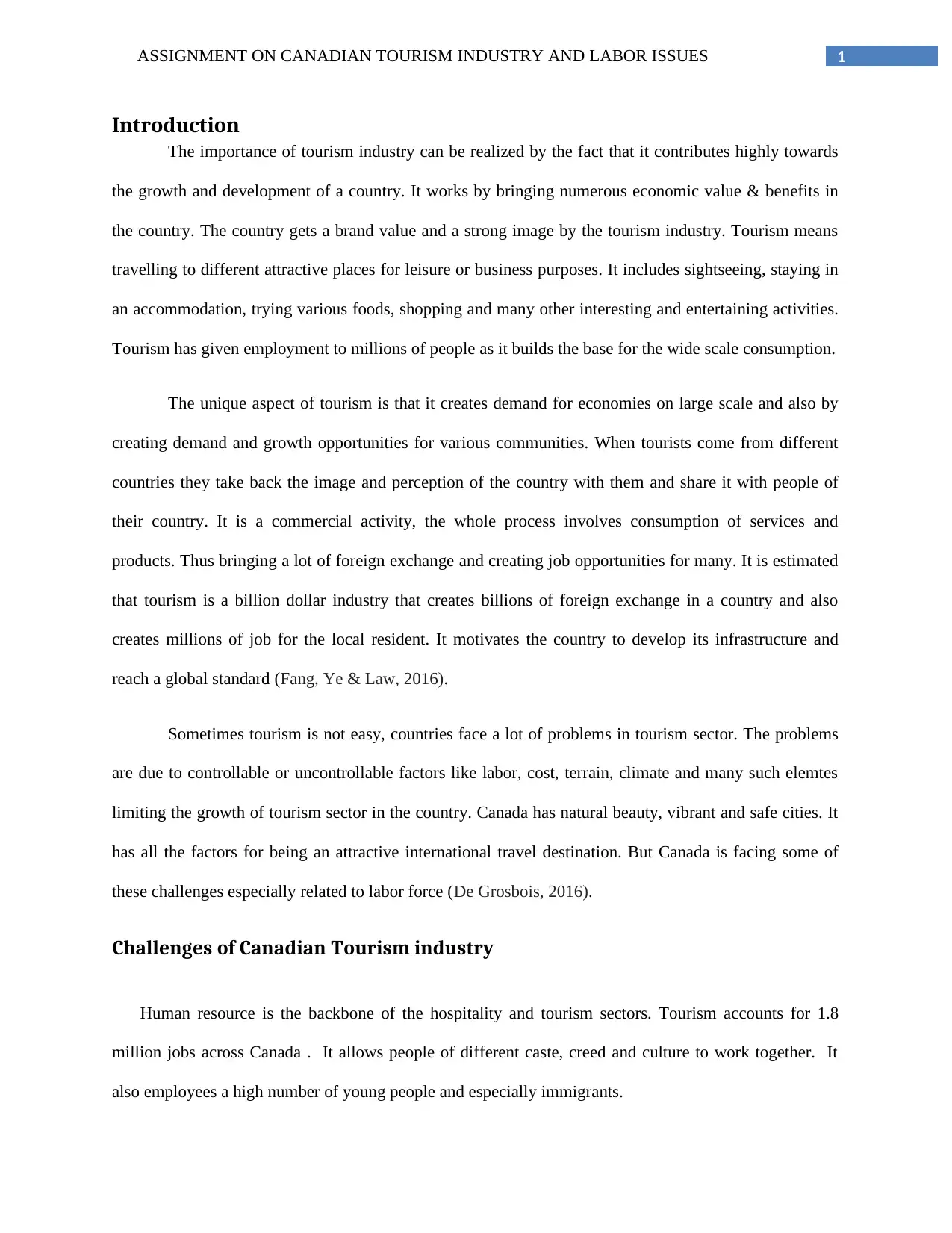
1ASSIGNMENT ON CANADIAN TOURISM INDUSTRY AND LABOR ISSUES
Introduction
The importance of tourism industry can be realized by the fact that it contributes highly towards
the growth and development of a country. It works by bringing numerous economic value & benefits in
the country. The country gets a brand value and a strong image by the tourism industry. Tourism means
travelling to different attractive places for leisure or business purposes. It includes sightseeing, staying in
an accommodation, trying various foods, shopping and many other interesting and entertaining activities.
Tourism has given employment to millions of people as it builds the base for the wide scale consumption.
The unique aspect of tourism is that it creates demand for economies on large scale and also by
creating demand and growth opportunities for various communities. When tourists come from different
countries they take back the image and perception of the country with them and share it with people of
their country. It is a commercial activity, the whole process involves consumption of services and
products. Thus bringing a lot of foreign exchange and creating job opportunities for many. It is estimated
that tourism is a billion dollar industry that creates billions of foreign exchange in a country and also
creates millions of job for the local resident. It motivates the country to develop its infrastructure and
reach a global standard (Fang, Ye & Law, 2016).
Sometimes tourism is not easy, countries face a lot of problems in tourism sector. The problems
are due to controllable or uncontrollable factors like labor, cost, terrain, climate and many such elemtes
limiting the growth of tourism sector in the country. Canada has natural beauty, vibrant and safe cities. It
has all the factors for being an attractive international travel destination. But Canada is facing some of
these challenges especially related to labor force (De Grosbois, 2016).
Challenges of Canadian Tourism industry
Human resource is the backbone of the hospitality and tourism sectors. Tourism accounts for 1.8
million jobs across Canada . It allows people of different caste, creed and culture to work together. It
also employees a high number of young people and especially immigrants.
Introduction
The importance of tourism industry can be realized by the fact that it contributes highly towards
the growth and development of a country. It works by bringing numerous economic value & benefits in
the country. The country gets a brand value and a strong image by the tourism industry. Tourism means
travelling to different attractive places for leisure or business purposes. It includes sightseeing, staying in
an accommodation, trying various foods, shopping and many other interesting and entertaining activities.
Tourism has given employment to millions of people as it builds the base for the wide scale consumption.
The unique aspect of tourism is that it creates demand for economies on large scale and also by
creating demand and growth opportunities for various communities. When tourists come from different
countries they take back the image and perception of the country with them and share it with people of
their country. It is a commercial activity, the whole process involves consumption of services and
products. Thus bringing a lot of foreign exchange and creating job opportunities for many. It is estimated
that tourism is a billion dollar industry that creates billions of foreign exchange in a country and also
creates millions of job for the local resident. It motivates the country to develop its infrastructure and
reach a global standard (Fang, Ye & Law, 2016).
Sometimes tourism is not easy, countries face a lot of problems in tourism sector. The problems
are due to controllable or uncontrollable factors like labor, cost, terrain, climate and many such elemtes
limiting the growth of tourism sector in the country. Canada has natural beauty, vibrant and safe cities. It
has all the factors for being an attractive international travel destination. But Canada is facing some of
these challenges especially related to labor force (De Grosbois, 2016).
Challenges of Canadian Tourism industry
Human resource is the backbone of the hospitality and tourism sectors. Tourism accounts for 1.8
million jobs across Canada . It allows people of different caste, creed and culture to work together. It
also employees a high number of young people and especially immigrants.
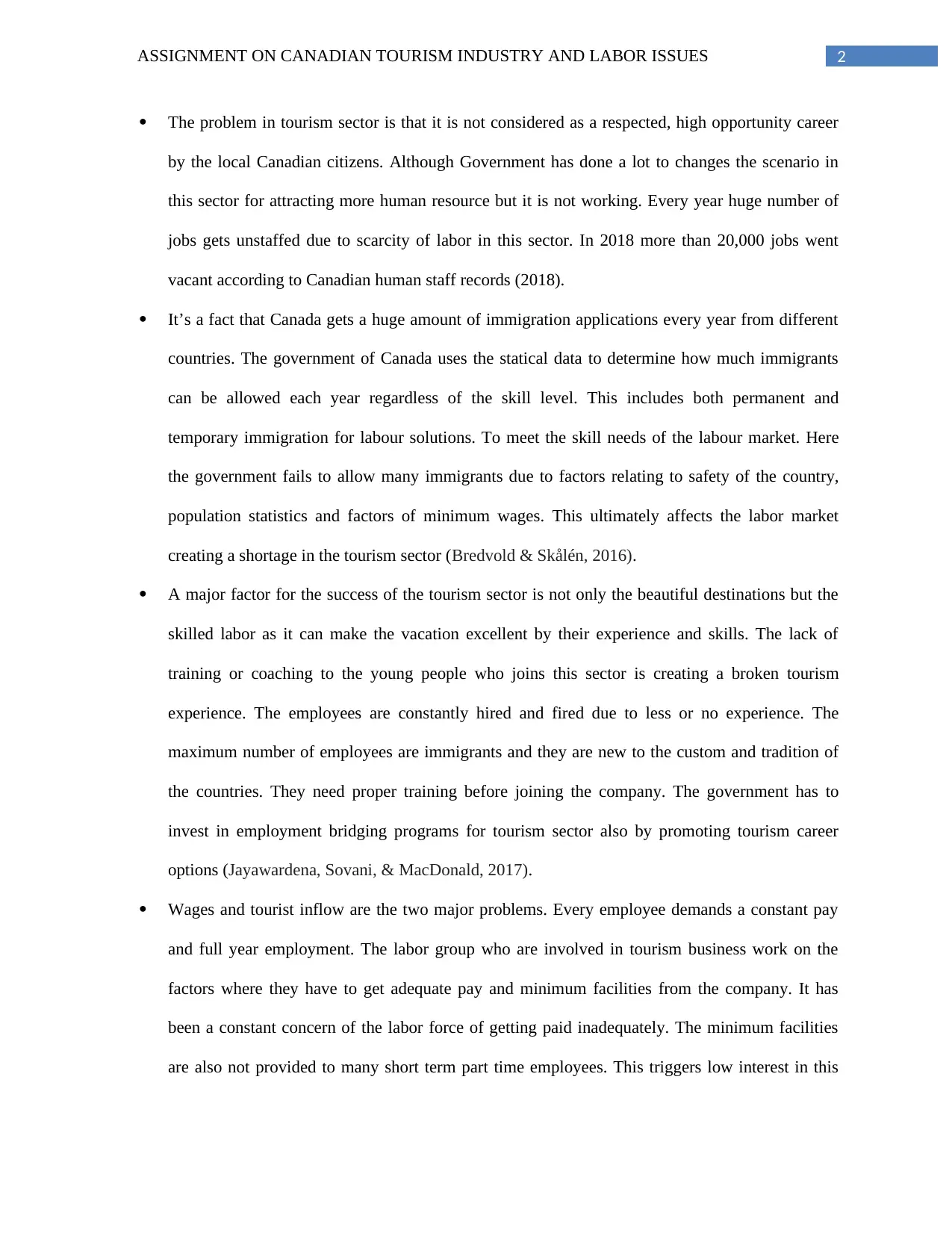
2ASSIGNMENT ON CANADIAN TOURISM INDUSTRY AND LABOR ISSUES
The problem in tourism sector is that it is not considered as a respected, high opportunity career
by the local Canadian citizens. Although Government has done a lot to changes the scenario in
this sector for attracting more human resource but it is not working. Every year huge number of
jobs gets unstaffed due to scarcity of labor in this sector. In 2018 more than 20,000 jobs went
vacant according to Canadian human staff records (2018).
It’s a fact that Canada gets a huge amount of immigration applications every year from different
countries. The government of Canada uses the statical data to determine how much immigrants
can be allowed each year regardless of the skill level. This includes both permanent and
temporary immigration for labour solutions. To meet the skill needs of the labour market. Here
the government fails to allow many immigrants due to factors relating to safety of the country,
population statistics and factors of minimum wages. This ultimately affects the labor market
creating a shortage in the tourism sector (Bredvold & Skålén, 2016).
A major factor for the success of the tourism sector is not only the beautiful destinations but the
skilled labor as it can make the vacation excellent by their experience and skills. The lack of
training or coaching to the young people who joins this sector is creating a broken tourism
experience. The employees are constantly hired and fired due to less or no experience. The
maximum number of employees are immigrants and they are new to the custom and tradition of
the countries. They need proper training before joining the company. The government has to
invest in employment bridging programs for tourism sector also by promoting tourism career
options (Jayawardena, Sovani, & MacDonald, 2017).
Wages and tourist inflow are the two major problems. Every employee demands a constant pay
and full year employment. The labor group who are involved in tourism business work on the
factors where they have to get adequate pay and minimum facilities from the company. It has
been a constant concern of the labor force of getting paid inadequately. The minimum facilities
are also not provided to many short term part time employees. This triggers low interest in this
The problem in tourism sector is that it is not considered as a respected, high opportunity career
by the local Canadian citizens. Although Government has done a lot to changes the scenario in
this sector for attracting more human resource but it is not working. Every year huge number of
jobs gets unstaffed due to scarcity of labor in this sector. In 2018 more than 20,000 jobs went
vacant according to Canadian human staff records (2018).
It’s a fact that Canada gets a huge amount of immigration applications every year from different
countries. The government of Canada uses the statical data to determine how much immigrants
can be allowed each year regardless of the skill level. This includes both permanent and
temporary immigration for labour solutions. To meet the skill needs of the labour market. Here
the government fails to allow many immigrants due to factors relating to safety of the country,
population statistics and factors of minimum wages. This ultimately affects the labor market
creating a shortage in the tourism sector (Bredvold & Skålén, 2016).
A major factor for the success of the tourism sector is not only the beautiful destinations but the
skilled labor as it can make the vacation excellent by their experience and skills. The lack of
training or coaching to the young people who joins this sector is creating a broken tourism
experience. The employees are constantly hired and fired due to less or no experience. The
maximum number of employees are immigrants and they are new to the custom and tradition of
the countries. They need proper training before joining the company. The government has to
invest in employment bridging programs for tourism sector also by promoting tourism career
options (Jayawardena, Sovani, & MacDonald, 2017).
Wages and tourist inflow are the two major problems. Every employee demands a constant pay
and full year employment. The labor group who are involved in tourism business work on the
factors where they have to get adequate pay and minimum facilities from the company. It has
been a constant concern of the labor force of getting paid inadequately. The minimum facilities
are also not provided to many short term part time employees. This triggers low interest in this
⊘ This is a preview!⊘
Do you want full access?
Subscribe today to unlock all pages.

Trusted by 1+ million students worldwide
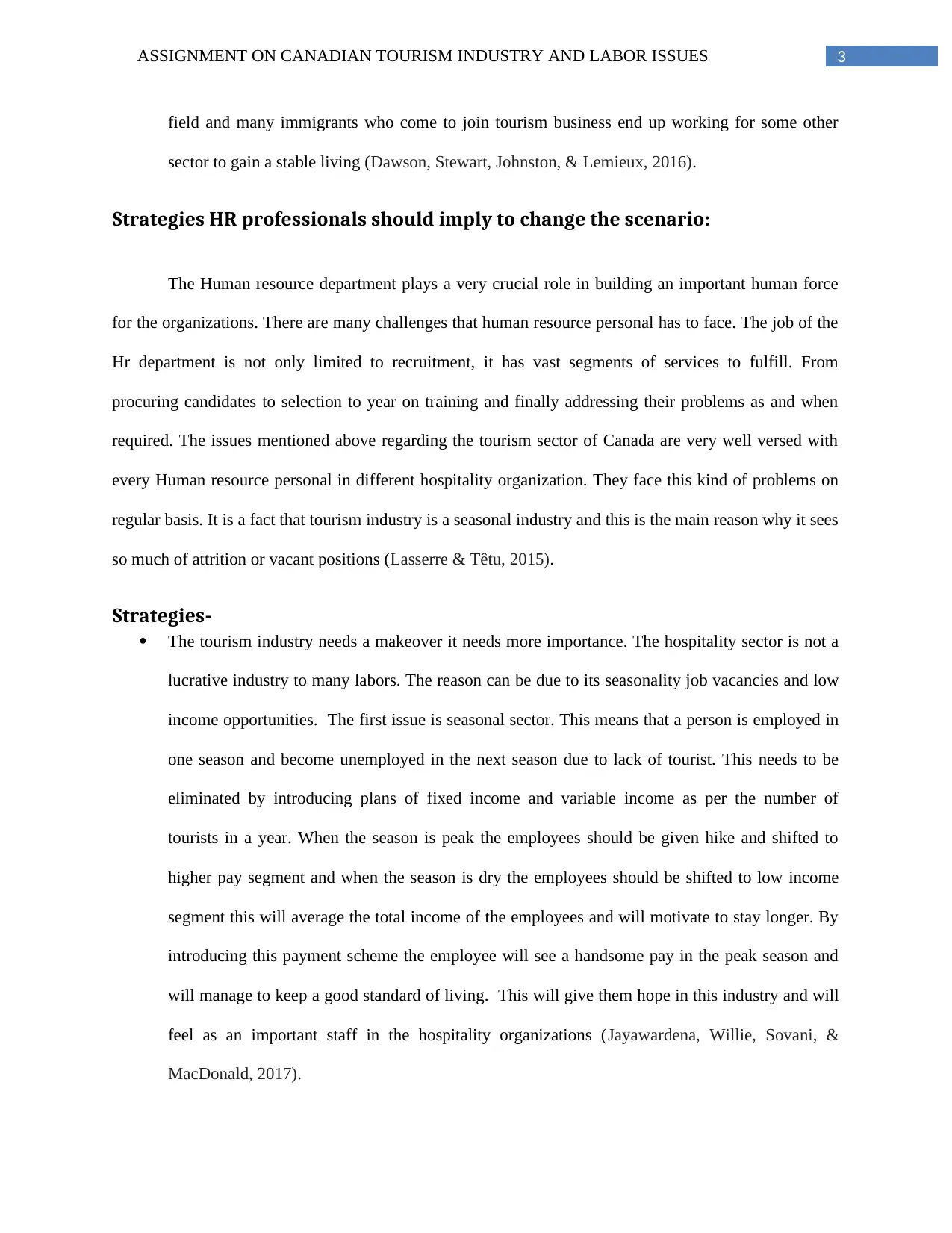
3ASSIGNMENT ON CANADIAN TOURISM INDUSTRY AND LABOR ISSUES
field and many immigrants who come to join tourism business end up working for some other
sector to gain a stable living (Dawson, Stewart, Johnston, & Lemieux, 2016).
Strategies HR professionals should imply to change the scenario:
The Human resource department plays a very crucial role in building an important human force
for the organizations. There are many challenges that human resource personal has to face. The job of the
Hr department is not only limited to recruitment, it has vast segments of services to fulfill. From
procuring candidates to selection to year on training and finally addressing their problems as and when
required. The issues mentioned above regarding the tourism sector of Canada are very well versed with
every Human resource personal in different hospitality organization. They face this kind of problems on
regular basis. It is a fact that tourism industry is a seasonal industry and this is the main reason why it sees
so much of attrition or vacant positions (Lasserre & Têtu, 2015).
Strategies-
The tourism industry needs a makeover it needs more importance. The hospitality sector is not a
lucrative industry to many labors. The reason can be due to its seasonality job vacancies and low
income opportunities. The first issue is seasonal sector. This means that a person is employed in
one season and become unemployed in the next season due to lack of tourist. This needs to be
eliminated by introducing plans of fixed income and variable income as per the number of
tourists in a year. When the season is peak the employees should be given hike and shifted to
higher pay segment and when the season is dry the employees should be shifted to low income
segment this will average the total income of the employees and will motivate to stay longer. By
introducing this payment scheme the employee will see a handsome pay in the peak season and
will manage to keep a good standard of living. This will give them hope in this industry and will
feel as an important staff in the hospitality organizations (Jayawardena, Willie, Sovani, &
MacDonald, 2017).
field and many immigrants who come to join tourism business end up working for some other
sector to gain a stable living (Dawson, Stewart, Johnston, & Lemieux, 2016).
Strategies HR professionals should imply to change the scenario:
The Human resource department plays a very crucial role in building an important human force
for the organizations. There are many challenges that human resource personal has to face. The job of the
Hr department is not only limited to recruitment, it has vast segments of services to fulfill. From
procuring candidates to selection to year on training and finally addressing their problems as and when
required. The issues mentioned above regarding the tourism sector of Canada are very well versed with
every Human resource personal in different hospitality organization. They face this kind of problems on
regular basis. It is a fact that tourism industry is a seasonal industry and this is the main reason why it sees
so much of attrition or vacant positions (Lasserre & Têtu, 2015).
Strategies-
The tourism industry needs a makeover it needs more importance. The hospitality sector is not a
lucrative industry to many labors. The reason can be due to its seasonality job vacancies and low
income opportunities. The first issue is seasonal sector. This means that a person is employed in
one season and become unemployed in the next season due to lack of tourist. This needs to be
eliminated by introducing plans of fixed income and variable income as per the number of
tourists in a year. When the season is peak the employees should be given hike and shifted to
higher pay segment and when the season is dry the employees should be shifted to low income
segment this will average the total income of the employees and will motivate to stay longer. By
introducing this payment scheme the employee will see a handsome pay in the peak season and
will manage to keep a good standard of living. This will give them hope in this industry and will
feel as an important staff in the hospitality organizations (Jayawardena, Willie, Sovani, &
MacDonald, 2017).
Paraphrase This Document
Need a fresh take? Get an instant paraphrase of this document with our AI Paraphraser
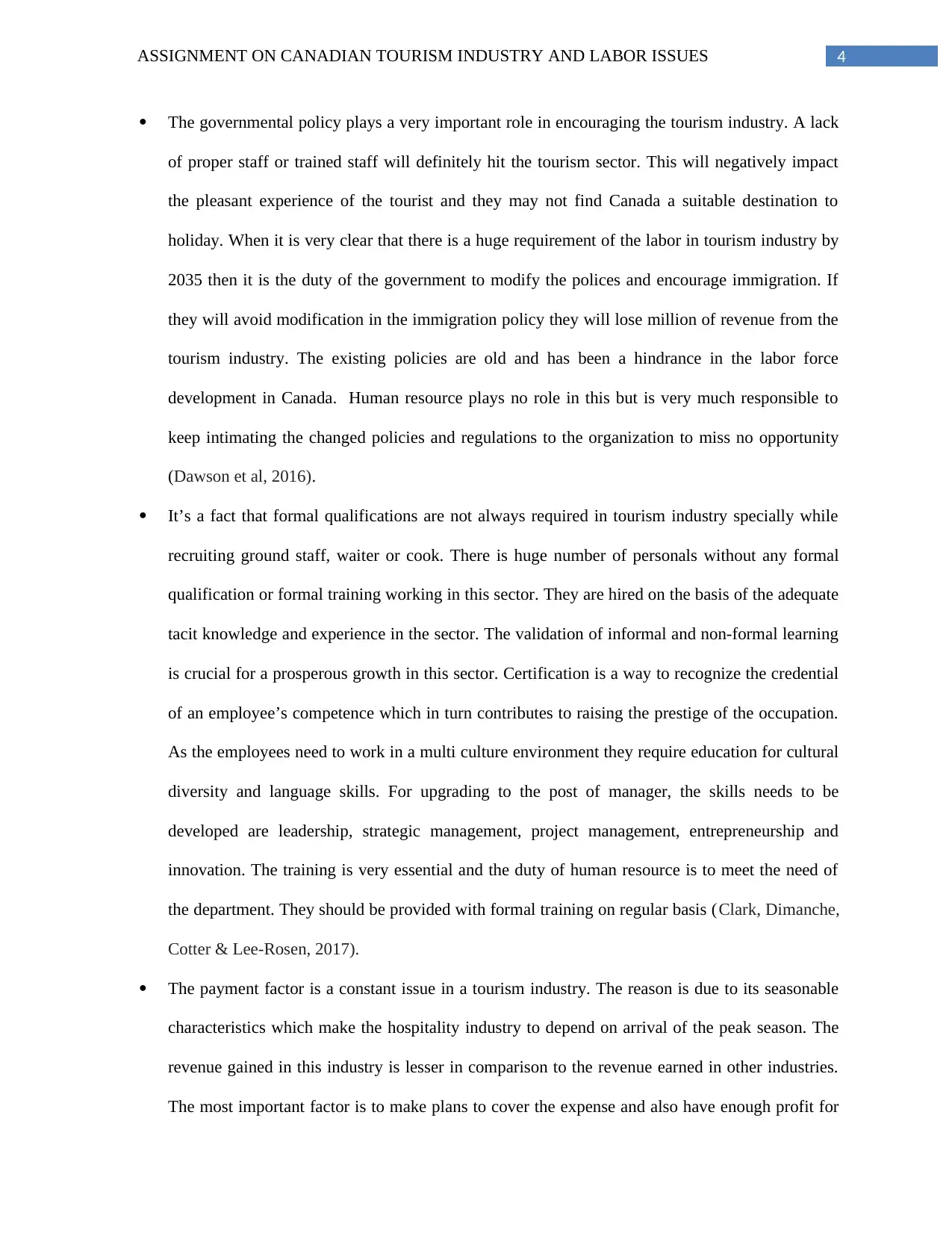
4ASSIGNMENT ON CANADIAN TOURISM INDUSTRY AND LABOR ISSUES
The governmental policy plays a very important role in encouraging the tourism industry. A lack
of proper staff or trained staff will definitely hit the tourism sector. This will negatively impact
the pleasant experience of the tourist and they may not find Canada a suitable destination to
holiday. When it is very clear that there is a huge requirement of the labor in tourism industry by
2035 then it is the duty of the government to modify the polices and encourage immigration. If
they will avoid modification in the immigration policy they will lose million of revenue from the
tourism industry. The existing policies are old and has been a hindrance in the labor force
development in Canada. Human resource plays no role in this but is very much responsible to
keep intimating the changed policies and regulations to the organization to miss no opportunity
(Dawson et al, 2016).
It’s a fact that formal qualifications are not always required in tourism industry specially while
recruiting ground staff, waiter or cook. There is huge number of personals without any formal
qualification or formal training working in this sector. They are hired on the basis of the adequate
tacit knowledge and experience in the sector. The validation of informal and non-formal learning
is crucial for a prosperous growth in this sector. Certification is a way to recognize the credential
of an employee’s competence which in turn contributes to raising the prestige of the occupation.
As the employees need to work in a multi culture environment they require education for cultural
diversity and language skills. For upgrading to the post of manager, the skills needs to be
developed are leadership, strategic management, project management, entrepreneurship and
innovation. The training is very essential and the duty of human resource is to meet the need of
the department. They should be provided with formal training on regular basis (Clark, Dimanche,
Cotter & Lee-Rosen, 2017).
The payment factor is a constant issue in a tourism industry. The reason is due to its seasonable
characteristics which make the hospitality industry to depend on arrival of the peak season. The
revenue gained in this industry is lesser in comparison to the revenue earned in other industries.
The most important factor is to make plans to cover the expense and also have enough profit for
The governmental policy plays a very important role in encouraging the tourism industry. A lack
of proper staff or trained staff will definitely hit the tourism sector. This will negatively impact
the pleasant experience of the tourist and they may not find Canada a suitable destination to
holiday. When it is very clear that there is a huge requirement of the labor in tourism industry by
2035 then it is the duty of the government to modify the polices and encourage immigration. If
they will avoid modification in the immigration policy they will lose million of revenue from the
tourism industry. The existing policies are old and has been a hindrance in the labor force
development in Canada. Human resource plays no role in this but is very much responsible to
keep intimating the changed policies and regulations to the organization to miss no opportunity
(Dawson et al, 2016).
It’s a fact that formal qualifications are not always required in tourism industry specially while
recruiting ground staff, waiter or cook. There is huge number of personals without any formal
qualification or formal training working in this sector. They are hired on the basis of the adequate
tacit knowledge and experience in the sector. The validation of informal and non-formal learning
is crucial for a prosperous growth in this sector. Certification is a way to recognize the credential
of an employee’s competence which in turn contributes to raising the prestige of the occupation.
As the employees need to work in a multi culture environment they require education for cultural
diversity and language skills. For upgrading to the post of manager, the skills needs to be
developed are leadership, strategic management, project management, entrepreneurship and
innovation. The training is very essential and the duty of human resource is to meet the need of
the department. They should be provided with formal training on regular basis (Clark, Dimanche,
Cotter & Lee-Rosen, 2017).
The payment factor is a constant issue in a tourism industry. The reason is due to its seasonable
characteristics which make the hospitality industry to depend on arrival of the peak season. The
revenue gained in this industry is lesser in comparison to the revenue earned in other industries.
The most important factor is to make plans to cover the expense and also have enough profit for
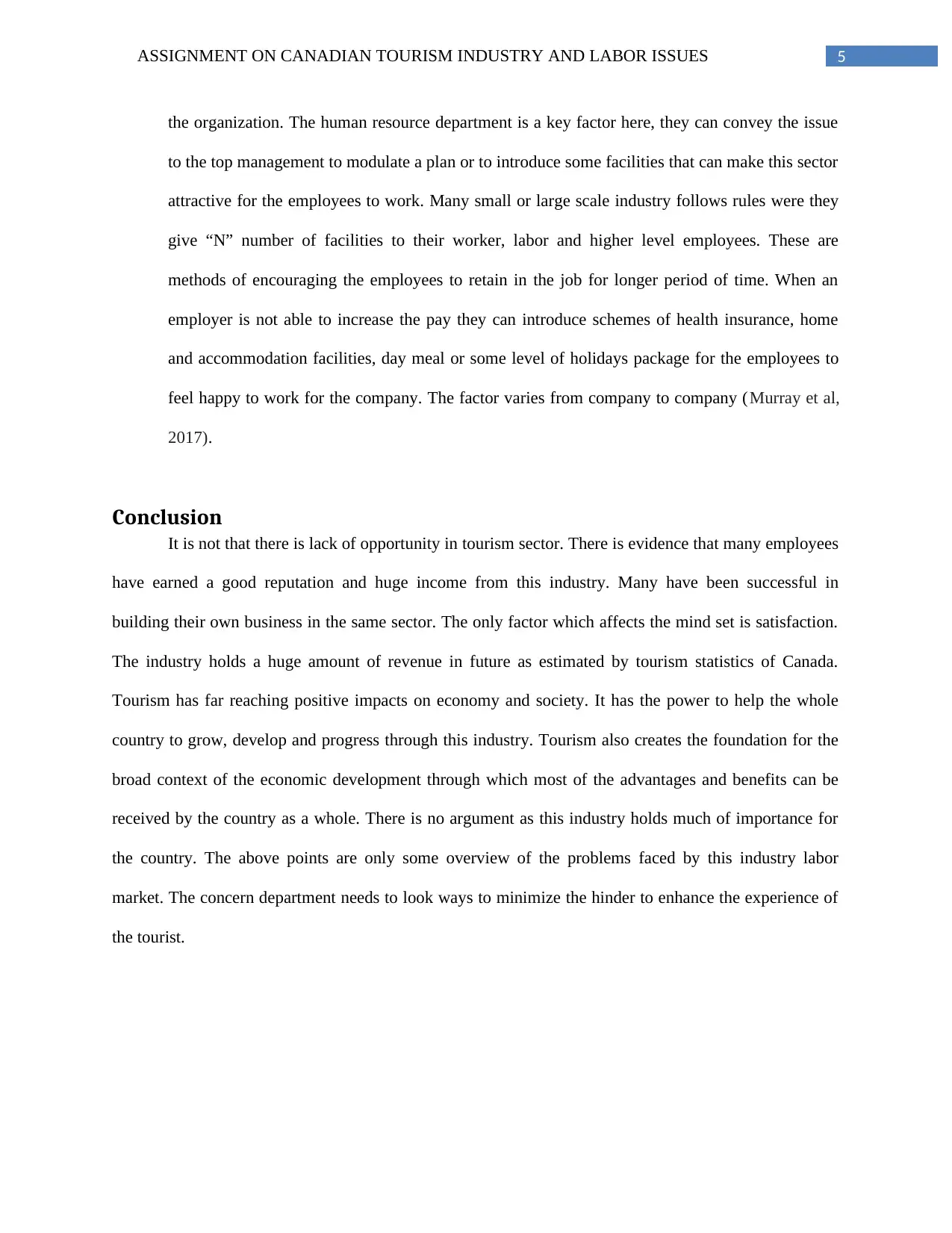
5ASSIGNMENT ON CANADIAN TOURISM INDUSTRY AND LABOR ISSUES
the organization. The human resource department is a key factor here, they can convey the issue
to the top management to modulate a plan or to introduce some facilities that can make this sector
attractive for the employees to work. Many small or large scale industry follows rules were they
give “N” number of facilities to their worker, labor and higher level employees. These are
methods of encouraging the employees to retain in the job for longer period of time. When an
employer is not able to increase the pay they can introduce schemes of health insurance, home
and accommodation facilities, day meal or some level of holidays package for the employees to
feel happy to work for the company. The factor varies from company to company (Murray et al,
2017).
Conclusion
It is not that there is lack of opportunity in tourism sector. There is evidence that many employees
have earned a good reputation and huge income from this industry. Many have been successful in
building their own business in the same sector. The only factor which affects the mind set is satisfaction.
The industry holds a huge amount of revenue in future as estimated by tourism statistics of Canada.
Tourism has far reaching positive impacts on economy and society. It has the power to help the whole
country to grow, develop and progress through this industry. Tourism also creates the foundation for the
broad context of the economic development through which most of the advantages and benefits can be
received by the country as a whole. There is no argument as this industry holds much of importance for
the country. The above points are only some overview of the problems faced by this industry labor
market. The concern department needs to look ways to minimize the hinder to enhance the experience of
the tourist.
the organization. The human resource department is a key factor here, they can convey the issue
to the top management to modulate a plan or to introduce some facilities that can make this sector
attractive for the employees to work. Many small or large scale industry follows rules were they
give “N” number of facilities to their worker, labor and higher level employees. These are
methods of encouraging the employees to retain in the job for longer period of time. When an
employer is not able to increase the pay they can introduce schemes of health insurance, home
and accommodation facilities, day meal or some level of holidays package for the employees to
feel happy to work for the company. The factor varies from company to company (Murray et al,
2017).
Conclusion
It is not that there is lack of opportunity in tourism sector. There is evidence that many employees
have earned a good reputation and huge income from this industry. Many have been successful in
building their own business in the same sector. The only factor which affects the mind set is satisfaction.
The industry holds a huge amount of revenue in future as estimated by tourism statistics of Canada.
Tourism has far reaching positive impacts on economy and society. It has the power to help the whole
country to grow, develop and progress through this industry. Tourism also creates the foundation for the
broad context of the economic development through which most of the advantages and benefits can be
received by the country as a whole. There is no argument as this industry holds much of importance for
the country. The above points are only some overview of the problems faced by this industry labor
market. The concern department needs to look ways to minimize the hinder to enhance the experience of
the tourist.
⊘ This is a preview!⊘
Do you want full access?
Subscribe today to unlock all pages.

Trusted by 1+ million students worldwide
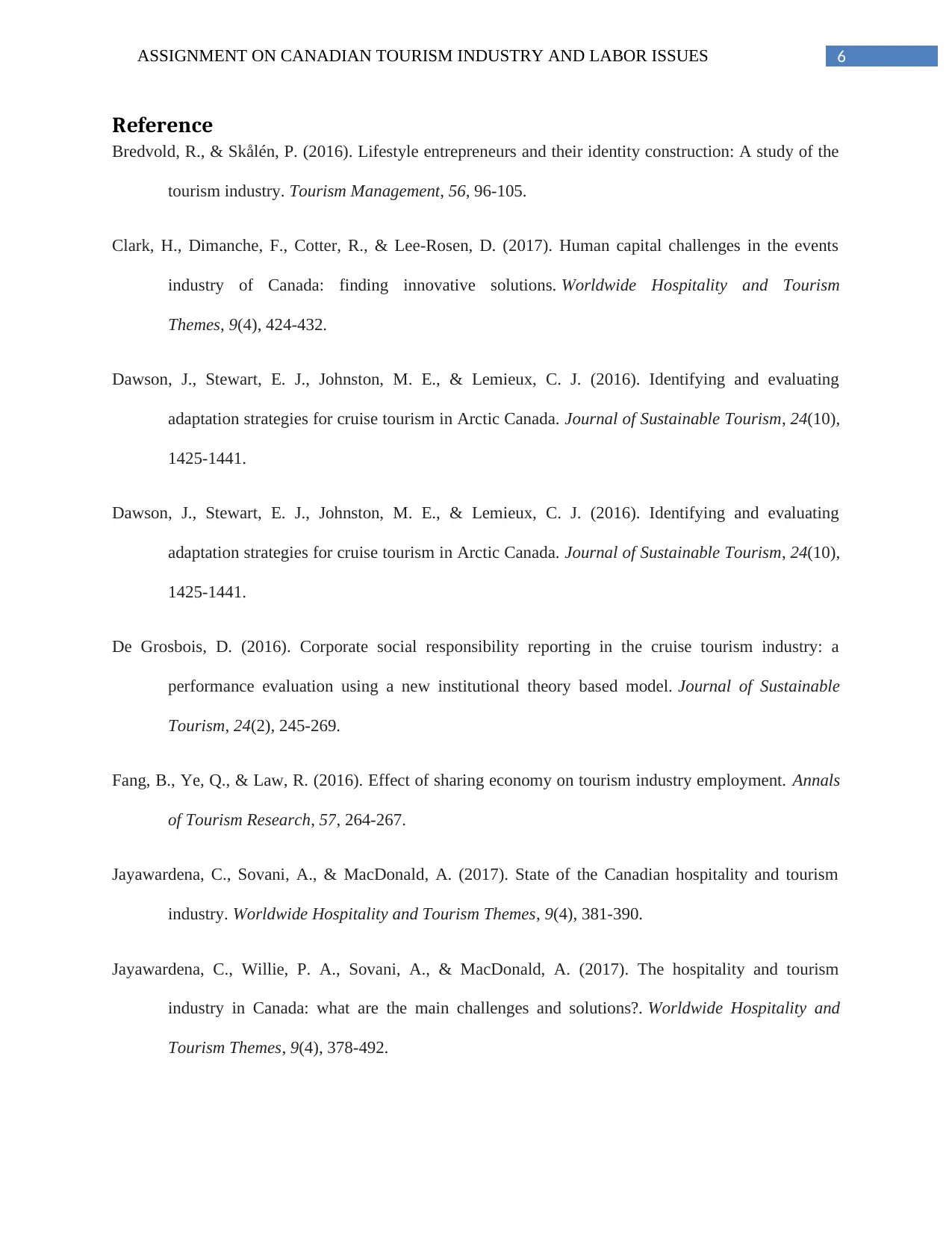
6ASSIGNMENT ON CANADIAN TOURISM INDUSTRY AND LABOR ISSUES
Reference
Bredvold, R., & Skålén, P. (2016). Lifestyle entrepreneurs and their identity construction: A study of the
tourism industry. Tourism Management, 56, 96-105.
Clark, H., Dimanche, F., Cotter, R., & Lee-Rosen, D. (2017). Human capital challenges in the events
industry of Canada: finding innovative solutions. Worldwide Hospitality and Tourism
Themes, 9(4), 424-432.
Dawson, J., Stewart, E. J., Johnston, M. E., & Lemieux, C. J. (2016). Identifying and evaluating
adaptation strategies for cruise tourism in Arctic Canada. Journal of Sustainable Tourism, 24(10),
1425-1441.
Dawson, J., Stewart, E. J., Johnston, M. E., & Lemieux, C. J. (2016). Identifying and evaluating
adaptation strategies for cruise tourism in Arctic Canada. Journal of Sustainable Tourism, 24(10),
1425-1441.
De Grosbois, D. (2016). Corporate social responsibility reporting in the cruise tourism industry: a
performance evaluation using a new institutional theory based model. Journal of Sustainable
Tourism, 24(2), 245-269.
Fang, B., Ye, Q., & Law, R. (2016). Effect of sharing economy on tourism industry employment. Annals
of Tourism Research, 57, 264-267.
Jayawardena, C., Sovani, A., & MacDonald, A. (2017). State of the Canadian hospitality and tourism
industry. Worldwide Hospitality and Tourism Themes, 9(4), 381-390.
Jayawardena, C., Willie, P. A., Sovani, A., & MacDonald, A. (2017). The hospitality and tourism
industry in Canada: what are the main challenges and solutions?. Worldwide Hospitality and
Tourism Themes, 9(4), 378-492.
Reference
Bredvold, R., & Skålén, P. (2016). Lifestyle entrepreneurs and their identity construction: A study of the
tourism industry. Tourism Management, 56, 96-105.
Clark, H., Dimanche, F., Cotter, R., & Lee-Rosen, D. (2017). Human capital challenges in the events
industry of Canada: finding innovative solutions. Worldwide Hospitality and Tourism
Themes, 9(4), 424-432.
Dawson, J., Stewart, E. J., Johnston, M. E., & Lemieux, C. J. (2016). Identifying and evaluating
adaptation strategies for cruise tourism in Arctic Canada. Journal of Sustainable Tourism, 24(10),
1425-1441.
Dawson, J., Stewart, E. J., Johnston, M. E., & Lemieux, C. J. (2016). Identifying and evaluating
adaptation strategies for cruise tourism in Arctic Canada. Journal of Sustainable Tourism, 24(10),
1425-1441.
De Grosbois, D. (2016). Corporate social responsibility reporting in the cruise tourism industry: a
performance evaluation using a new institutional theory based model. Journal of Sustainable
Tourism, 24(2), 245-269.
Fang, B., Ye, Q., & Law, R. (2016). Effect of sharing economy on tourism industry employment. Annals
of Tourism Research, 57, 264-267.
Jayawardena, C., Sovani, A., & MacDonald, A. (2017). State of the Canadian hospitality and tourism
industry. Worldwide Hospitality and Tourism Themes, 9(4), 381-390.
Jayawardena, C., Willie, P. A., Sovani, A., & MacDonald, A. (2017). The hospitality and tourism
industry in Canada: what are the main challenges and solutions?. Worldwide Hospitality and
Tourism Themes, 9(4), 378-492.
Paraphrase This Document
Need a fresh take? Get an instant paraphrase of this document with our AI Paraphraser
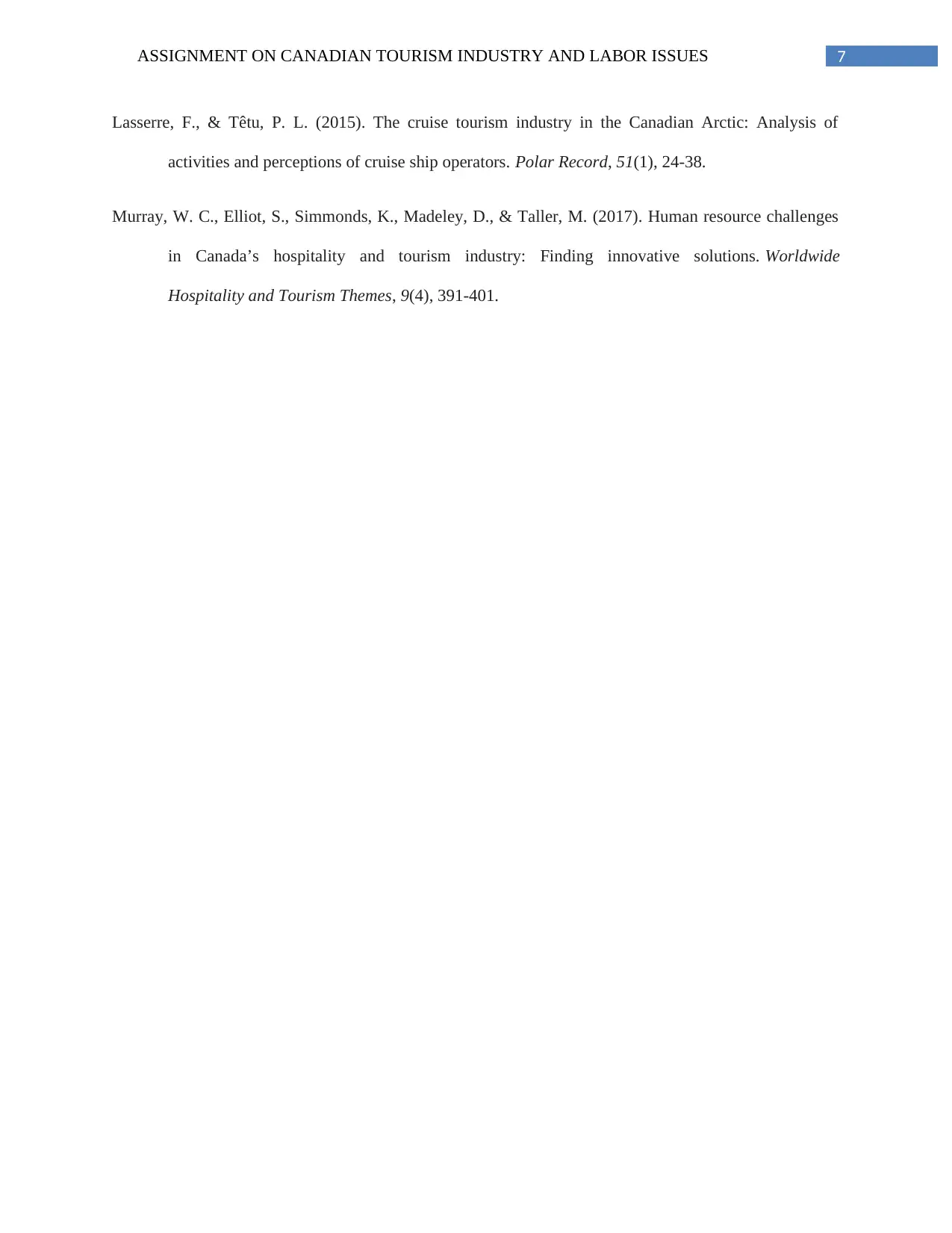
7ASSIGNMENT ON CANADIAN TOURISM INDUSTRY AND LABOR ISSUES
Lasserre, F., & Têtu, P. L. (2015). The cruise tourism industry in the Canadian Arctic: Analysis of
activities and perceptions of cruise ship operators. Polar Record, 51(1), 24-38.
Murray, W. C., Elliot, S., Simmonds, K., Madeley, D., & Taller, M. (2017). Human resource challenges
in Canada’s hospitality and tourism industry: Finding innovative solutions. Worldwide
Hospitality and Tourism Themes, 9(4), 391-401.
Lasserre, F., & Têtu, P. L. (2015). The cruise tourism industry in the Canadian Arctic: Analysis of
activities and perceptions of cruise ship operators. Polar Record, 51(1), 24-38.
Murray, W. C., Elliot, S., Simmonds, K., Madeley, D., & Taller, M. (2017). Human resource challenges
in Canada’s hospitality and tourism industry: Finding innovative solutions. Worldwide
Hospitality and Tourism Themes, 9(4), 391-401.
1 out of 8
Related Documents
Your All-in-One AI-Powered Toolkit for Academic Success.
+13062052269
info@desklib.com
Available 24*7 on WhatsApp / Email
![[object Object]](/_next/static/media/star-bottom.7253800d.svg)
Unlock your academic potential
Copyright © 2020–2025 A2Z Services. All Rights Reserved. Developed and managed by ZUCOL.




